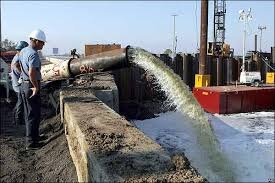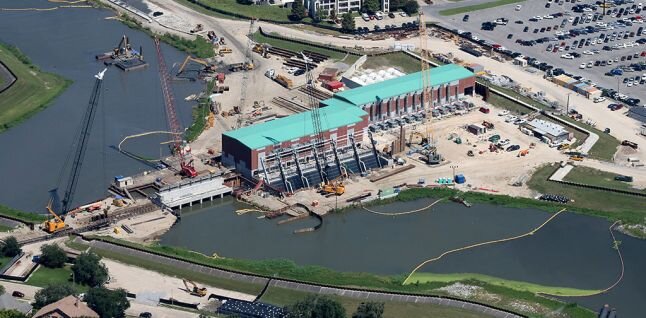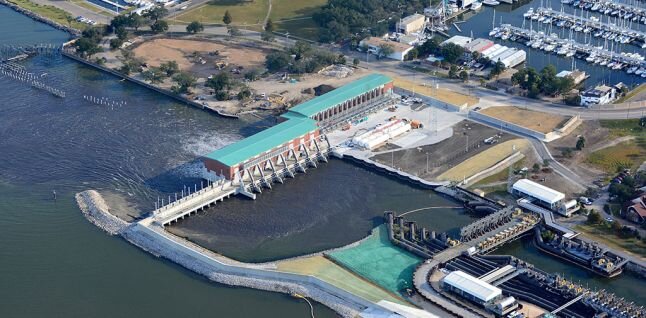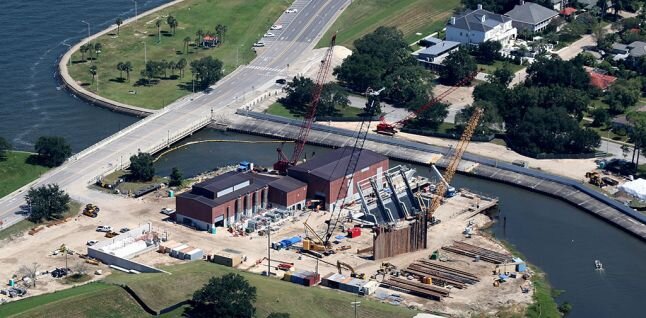Pump Stations Protect New Orleans - Hurricane Katrina's 10th Anniversary
/Ten years after Hurricane Katrina's massive devastation, Congress approved $14 billion for a 350-mile ring of protection around New Orleans with a promise to build bigger and stronger levees. The construction of pump stations have been built and more are in progress to keep the city’s three main drainage canals from being overwhelmed by future storms.
By Michelle Segrest, Navigate Content, Inc. Reporting for Empowering Pumps (originally published August 29, 2015)




On August 29, 2005, a brutal storm swept through the Gulf Coast and demolished most of New Orleans, burying more than 80 percent of the Crescent City under 15 feet of brackish water and debris, and leaving in its wake utter despair for its residents.
Hurricane Katrina made landfall about one hour south of New Orleans at Buras, Louisiana in Plaquemines Parish. It moved at Category 5 strength less than 12 hours prior to landfall and generated a 28-foot storm surge and 55-foot waves. It ignored the city’s flood walls and broke through with tragic force.
Surge and waves caused 50 major levee breaches in the regional Hurricane and Storm Damage Risk Reduction System (HSDRRS). Thirty-four of the city’s 71 pumping stations were damaged, and 169 of the system’s 350 miles of protective structures were compromised. Heavy rainfall of 14 inches in a 24-hour period further contributed to the excessive flooding.
Homes were ripped from their foundations. Businesses were destroyed. Millions of people were left homeless, and more than 2,000 people died. It is considered to be one of the worst natural disasters in United States history.
New Orleans Tries to Rebuild in the Aftermath of Hurricane Katrina
In the aftermath, Congress approved $14 billion for a 350-mile ring of protection around the city with a promise to build bigger and stronger levees. The construction of pump stations have been built and more are in progress to keep the city’s three main drainage canals from being overwhelmed by future storms.
The permanent pump stations and storm surge gates under construction at the ends of the 17th Street, Orleans Avenue and London Avenue canals were 50 percent complete (according to NOLA.com|The Times-Picayune) as Hurricane Katrina’s 10th anniversary approached and were on track to be turned over to the New Orleans Sewerage & Water Board before the June 1 start of the 2017 hurricane season.
Permanent Pump Stations for New Orleans’ Canals
When there’s a threat of storm surge from hurricanes entering the drainage canals, the combined permanent pump stations and gates at the ends of the three canals will operate. Even though the water was three to six feet below the top of the 14-foot above sea level wall, the weight of the surge water during Katrina caused part of the eastern flood wall along the 17th Street Canal to move inward by about 35 feet.
Water in the Orleans Avenue Canal escaped through a hole in the wall on the canal’s southern end near an interior pump station that had not been completed. This contributed to the flooding of City Park and Gentilly. In the London Avenue Canal, water was pushed through sand beneath walls on both sides of the canal, resulting in the failure of flood walls in several locations.
By building a combined pump station and flood gates at the end of each canal, officials hoped to avoid future flood wall failures.
The bottom of the funnel in the Orleans Avenue Canal will be at 40 feet below sea level. Placing the bottom of the structure that low gives the city of New Orleans the future option of digging the canals deep enough to remove the interior pump stations, allowing water to flow by gravity to the pump station. The new pump station was built to operate year-round.
The bottom of the funnels at the 17th Street and London Avenue canals will be at 50 feet below sea level to allow for gravity drainage.
Permanent Canal Closure Project (PCCP) Pump Stations
The pump stations for the Permanent Canal Closure Project (PCCP) were built by PCCP Constructors JV, a joint venture of Kiewit Louisiana Co., Traylor Bros. Inc., and the M.R. Pittman Group LLC, which won a contentious bidding war with a low bid of $615 million in April 2013. Change orders, including an additional $15.9 million awarded in March 2015 to pay for a change in electrical switches in the stations, have increased the project cost to its present level.
Seventeen gigantic pumps from Patterson Pump Company, powered by Baldor Electric gear motors, will manage the water levels on three New Orleans canals. They were designed to pump 11 million gallons per minute from the canals to nearby Lake Pontchartrain, protecting storm surges from topping the flood walls.
The 17 Patterson pumps included 10 smaller pumps. The large pumps operate at 1,800 cubic feet per second (1.2 gpm) with 10×10 square discharge, while the small pumps operate at 900 cfs (400,000 gpm).
Powering the New Orleans Pump Stations with Horizontal Gear Motors and VFDs
The Baldor Electric motors are based on horizontal gear motors typically supplied to the mining industry. Baldor chose to use to a vertical design for pumping applications. Instead of a traditional high-horsepower, high-pole-count, single-speed induction motor or synchronous motor, Baldor’s design uses a relatively low-pole-count motor coupled to a single reduction planetary reducer for higher efficiency and lower maintenance.
Each customized motor has a variable-frequency drive (VFD). For the smaller motors, the VFD provides flow control that might be useful for the operation of the pump stations. On the larger units, the VFDs enable 10 starts per hour. This contrasts with a typical design, which has to cool down for four hours before it can be restarted.
Although they run off line power under normal conditions, hurricane conditions require the motors to run off diesel power. The pump stations will have stand-alone power and enough diesel fuel to power generators for five days in the event of an emergency.
The PCCP project was scheduled for completion in 2017. The Orleans Avenue pump station will use three of the smaller pumps. The London Avenue station will have four large and two small pumps. The 17th Street station will have six large and two small pumps.
Monster Pump Station with Major Storm Resilience
Upon completion, each of the Orleans intake structures will be able to suck in 900 cubic feet per second of water, allowing the pumps to remove 2,700 cubic feet per second of rainwater from the canal.
The pumps will only be operated when gates connected to the pump station shut off the canal to water flowing in from Lake Pontchartrain. The gates will only be closed during tropical events to block storm surge from the lake from entering the canals.
The 17th Street pump station will be able to move 12,600 cubic feet per second of water, while the London Avenue station will handle 9,000 cubic feet per second. When all three are pumping at capacity, they will be able to remove the equivalent of the amount of water held by an Olympic-sized pool every 3.6 seconds.
Temporary storm surge gates and pumps remain in place in all three canals, just inside the construction sites, and will be used during storms until the permanent gates are completed.
Read this update: Price of now-completed pump stations at New Orleans outfall canals rises by $33.2 million
Progress and prevention are in place. Mitchell J. Landrieu, the Mayor of New Orleans, published uplifting comments on the website Katrina10.org, where you can find a magnitude of inspiring stories on the rebuilding of a great city.
“The New Orleans region has now returned to approximately 95 percent of its pre-Katrina population, major rebuilding projects have been completed or are underway, and the region has received major accolades in the areas of criminal justice reform, K-12 education reform, economic development and entrepreneurship, and neighborhood revitalization. New Orleans has become this nation’s—and in many instances, this world’s—most immediate laboratory for innovation and change. Now, the opportunity is to position New Orleans as a global leader on resilience.
“New Orleans has come a long way. It’s safe to say this is America’s best comeback story. But it also true that we have got a lot more work to do to tackle some longstanding, generational challenges around crime, education, income inequality and infrastructure. On this 10th anniversary, we will reflect on the loss and celebrate the progress made, as well honor those around the world who have helped our region recover. And we will focus on the road we have ahead of us together.”
According to an article about the PCCP by Kiewit Engineering, here are some other interesting facts:
At least 379,000 residents of Orleans and Jefferson Parishes will be impacted by the risk reduction provided by the PCCP project.
The three pump stations can pump a combined 24,300 cfs — enough water to fill an Olympic-size swimming pool in 3.64 seconds, or New Orleans’ Superdome in less than 90 minutes.
The entire project placed 70,000 cubic yards of structural concrete — enough to cover the entire floor space of the Superdome with a slab over seven-feet thick.
The 7,000 tons of reinforcing steel used on the project surpasses the weight of the steel in the Gateway Arch in St. Louis by 1,000 tons.
If laid end to end, the permanent pile used on the project would stretch almost 50 miles.
If you like this article about the pump stations and 10th Anniversary of Hurricane Katrina, please PIN IT!
This page contains affiliate links. If you click on the product links and make a purchase, it allows me to make a small commission at no extra cost to you! Thank you for your support and I hope you find value in this content!
More Resources Used in this Article:
http://www.nytimes.com/2015/08/08/science/louisiana-10-years-after-hurricane-katrina.html
http://www.nola.com/environment/index.ssf/2015/05/new_orleans_canal_permanent_pu.html
http://www.mvn.usace.army.mil/Missions/HSDRRS/RiskReductionPlan.aspx
http://bv.com/Projects/usace-permanent-canal-closures-pump-stations-study
http://www.automationworld.com/monster-pumps-will-protect-new-orleans-flooding











